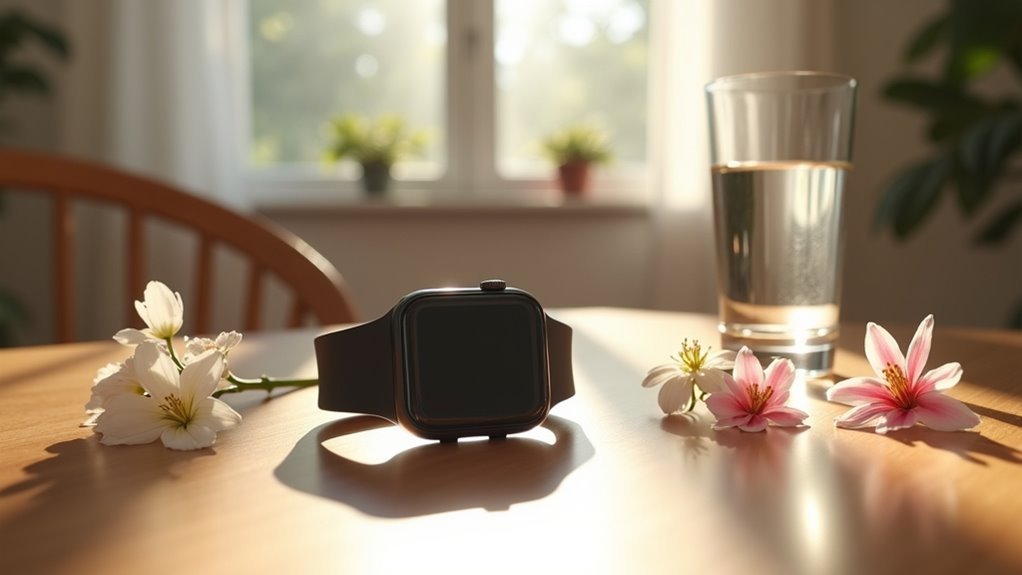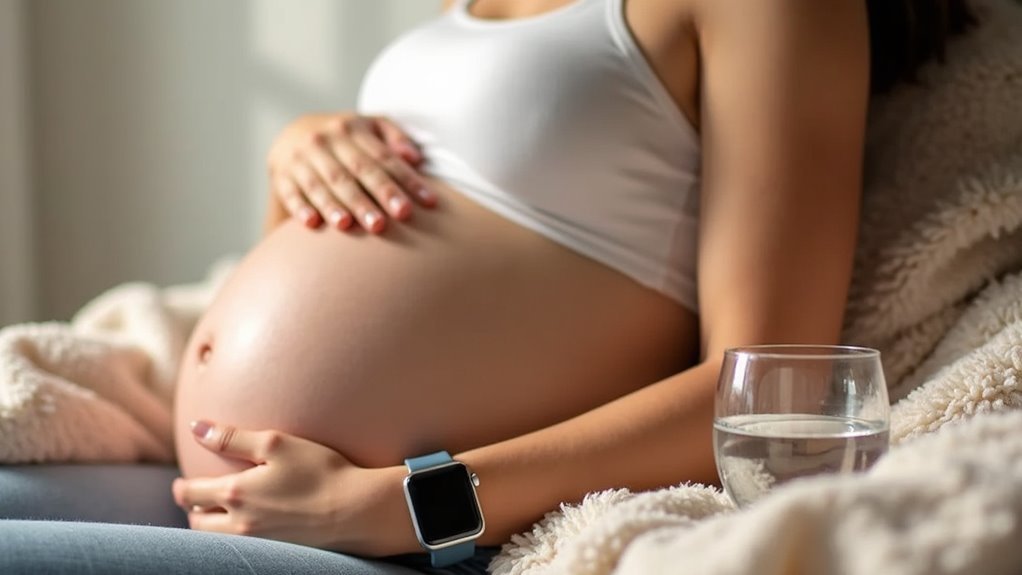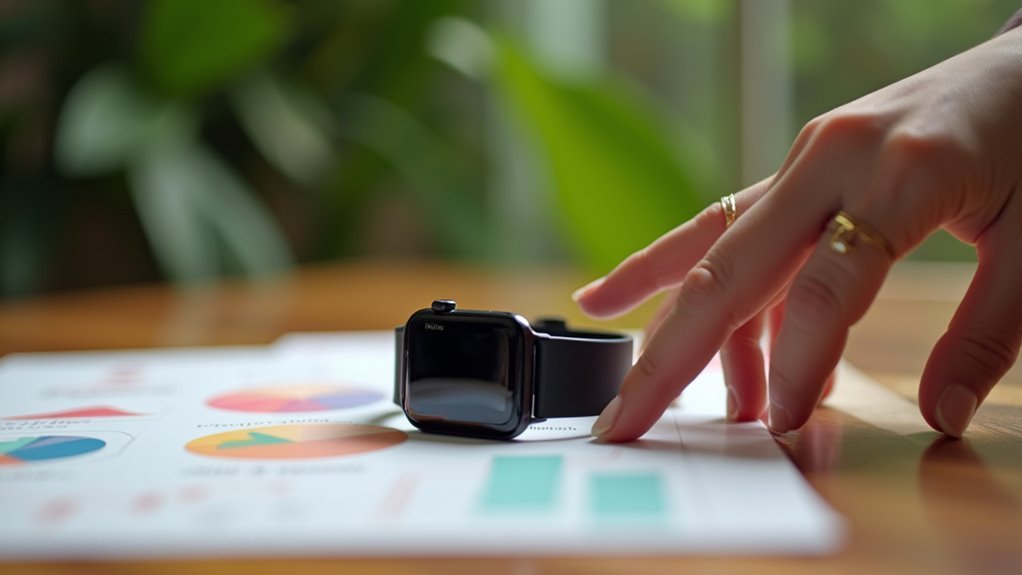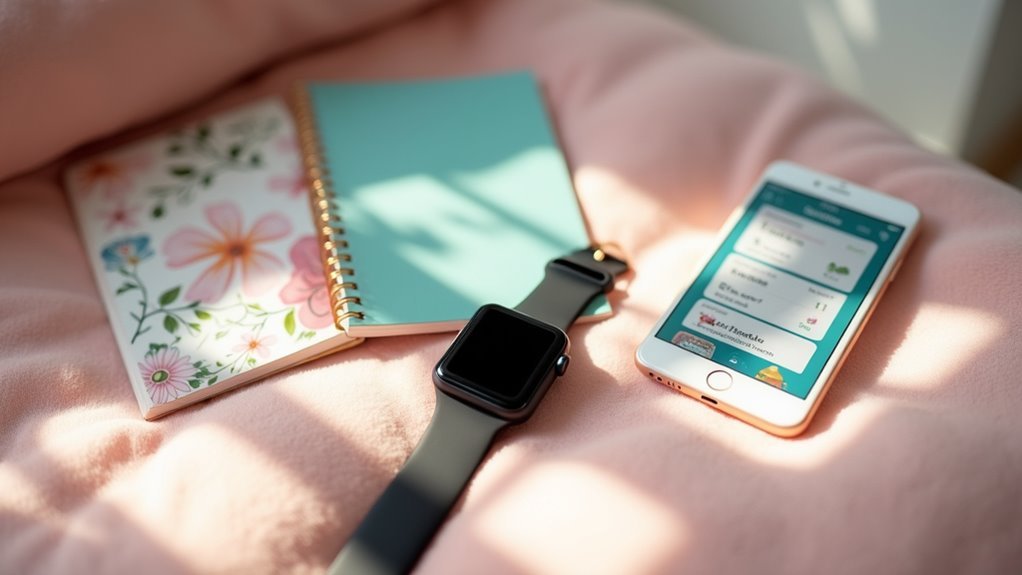You need specialized hydration tracking devices because your body processes fluids differently than men’s due to hormonal fluctuations, higher body fat percentage, and unique sweat patterns. Your estrogen and progesterone levels constantly change your fluid retention needs throughout your menstrual cycle, pregnancy, and menopause. Standard devices can’t account for your higher sweat gland density, different sweat distribution zones, or reduced thirst sensitivity as you age. Understanding these physiological differences will help you optimize your hydration strategy.
Unique Female Physiology Demands Different Hydration Approaches

While many hydration guidelines treat all bodies the same, your female physiology creates distinct hydration needs that standard recommendations often miss.
Your higher body fat percentage means you store less water than men, while your lower sweat rates actually help you retain fluid in hot, humid conditions.
However, hormonal fluctuations throughout your menstrual cycle greatly impact your hydration requirements. Estrogen acts as a fluid-retaining hormone, while progesterone creates a diuretic effect, causing your needs to shift dramatically between cycle phases.
Your smaller muscle mass produces less metabolic heat during exercise, affecting how much you sweat. You achieve greater sweating efficiency by using more sweat glands while producing less sweat per gland compared to men.
These physiological differences mean generic hydration advice doesn’t account for your body’s unique patterns.
How Hormonal Fluctuations Impact Water Balance Throughout Life
Your hormones don’t just influence your monthly cycle—they orchestrate a complex dance of fluid regulation that changes throughout your entire life. Estrogen increases water retention and osmotic sensitivity, while progesterone can act as a natural diuretic by competing with aldosterone at mineralocorticoid receptors.
| Life Stage | Estrogen Effect | Hydration Challenge |
|---|---|---|
| Menstrual Years | Cyclical fluctuations | Monthly bloating, variable fluid needs |
| Perimenopause | Erratic spikes/drops | Tissue puffiness, unpredictable retention |
| Menopause | Dramatic decline | Reduced thirst sensitivity, dehydration risk |
| Post-menopause | Consistently low | Increased hyponatremia risk |
| HRT Users | Artificial elevation | Rapid water retention, careful monitoring needed |
These hormonal shifts directly impact your blood pressure response to sodium and can mask true dehydration when thirst signals weaken with age. When the hypothalamus detects dehydration, it triggers cortisol release, which can further disrupt your body’s natural fluid balance mechanisms.
Pregnancy and Postpartum Hydration Challenges Require Dynamic Monitoring

During pregnancy, your body’s fluid demands skyrocket as blood volume increases by 40-50% and amniotic fluid production requires constant replenishment.
You’ll need 1.9 to 3.0 liters daily—significantly more than before conception. Underhydration can trigger headaches, constipation, and dangerously low amniotic fluid levels that threaten fetal development.
As you progress through your second and third trimesters, staying adequately hydrated becomes increasingly challenging due to heightened water output.
After delivery, you’ll face new hydration obstacles: significant postpartum fluid loss and breastfeeding’s additional demands on your water reserves. Many women struggle with lack of thirst and forgetfulness when it comes to maintaining adequate water intake during this critical period.
Traditional “eight glasses daily” advice can’t accommodate these dramatic physiological shifts.
You need dynamic monitoring that adjusts recommendations based on your changing body, activity level, climate, and whether you’re nursing—making specialized hydration tracking essential for protecting both your health and your baby’s.
Female-Specific Sweat Patterns Call for Specialized Sensor Technology
Because women’s sweat distribution concentrates in distinctly different areas than men’s—particularly the central upper back, heels, feet, and between breasts—traditional hydration tracking devices miss the mark entirely.
Your central upper back produces 223 g·m·h of sweat, while your heels generate 161 g·m·h, yet most wearables focus on male-dominant zones like forearms.
Women’s sweat peaks at 223 g·m·h on the upper back, yet wearables ignore these zones for male-focused forearm tracking.
You’ll also start sweating at higher core temperatures than men, and despite having higher sweat gland density, your overall output per gland is lower.
This means algorithms calibrated for male patterns can’t accurately estimate your fluid needs. Women experience four distinct patterns of hot flashes and night sweats that can significantly impact hydration needs throughout different life stages.
You need sensors specifically designed for female anatomy—devices that map your unique sweat regions and adjust for your metabolic differences to prevent underhydration during exercise.
Health Risks Women Face From Inadequate Hydration Tracking

Inadequate hydration tracking puts women at serious health risks that extend far beyond exercise performance.
During pregnancy, you’ll face increased water needs in your second and third trimesters, yet you’re likely unaware of specific hydration guidelines. Without proper tracking, you risk maternal under-hydration that’s linked to inadequate amniotic fluid levels and disrupted fetal brain development. Your baby could face low birth weight and adverse developmental outcomes when your fluid intake isn’t monitored.
You’ll also experience cognitive effects and negative mood changes from reduced fluid intake.
The challenge intensifies because you often forget to drink water and over- or under-report your beverage consumption without accurate tracking methods. Research shows that smart water bottles can effectively sync with smartphone apps to measure your daily intake and promote better hydration habits. This knowledge gap about recommended fluid intake creates dangerous health consequences for both you and your developing child.
Design Features That Make Wearables Work Better for Women
While hydration tracking technology has advanced rapidly, you’ll find that most devices haven’t been optimized for women’s unique physiological needs and lifestyle preferences. Women require specialized design features that account for smaller body sizes, different sweat rates, and variable heart rate patterns influenced by hormonal changes.
| Design Category | Female-Specific Features | Benefits |
|---|---|---|
| Sensor Technology | Photoplethysmographic sensors adapted for skin pigmentation | Enhanced accuracy across diverse skin types |
| Form Factor | Clip-on sensors and skin patches | Unobtrusive monitoring during activities |
| User Interface | Speedometer-style hydration graphics | Quick understanding for busy schedules |
| Comfort | Adjustable straps for smaller circumferences | Better fit and consistent wear |
| Integration | Compatibility with women’s health apps | Holistic wellness tracking ecosystem |
These features guarantee you’ll get accurate, actionable hydration insights. When selecting hydration tracking devices, women should prioritize brands that focus on accuracy and privacy to ensure reliable health monitoring and secure data protection.
Menstrual Cycle Integration in Smart Hydration Algorithms
As hormonal fluctuations reshape your body’s water needs throughout each menstrual cycle, cutting-edge hydration algorithms now adapt their recommendations to match these predictable physiological changes.
Your wearable device combines self-reported cycle data with continuous physiological monitoring—tracking heart rate, skin temperature, and sweating patterns—to identify which phase you’re experiencing.
Machine learning algorithms analyze these patterns to deliver phase-specific hydration guidance. During ovulation, when your body temperature rises and increases water loss, you’ll receive adjusted fluid intake recommendations.
When you’re experiencing pre-menstrual sodium retention, the algorithm reduces suggested water consumption accordingly.
This integration transforms generic hydration advice into personalized recommendations that account for your hormonal shifts, reducing dehydration risks while preventing overhydration during phases when your body naturally retains more fluid. These personalized models can significantly improve tracking accuracy compared to one-size-fits-all approaches.
Real-Time Electrolyte Monitoring for Female Athletes and Active Women
Your body’s electrolyte losses differ markedly from men’s due to hormonal fluctuations and physiological variations that standard hydration devices often miss.
Real-time monitoring technology now tracks your specific sodium, potassium, and magnesium losses through advanced sweat sensors, providing personalized data that adapts to your menstrual cycle and training demands.
These insights enable you to optimize your electrolyte replacement strategy, preventing performance-limiting imbalances before they impact your athletic output. The technology delivers real-time notifications directly to your phone, watch, or bike computer to ensure immediate awareness of your hydration status during training.
Gender-Specific Electrolyte Loss
Because women face unique physiological challenges that affect hydration and electrolyte balance during exercise, you need specialized monitoring technology that accounts for these gender-specific differences.
Your body loses electrolytes differently than men’s during physical activity, with research showing distinct patterns in sodium shedding and fluid tolerance. You’re more sensitive to hypohydration, meaning even a 0.5% fluid loss can impair your core temperature regulation and performance.
Your higher body fat percentage creates lower water reserves, making you less tolerant of fluid loss. You’re also at greater risk for hyponatremia, particularly when consuming large amounts of fluid without proper sodium replacement.
These physiological differences require customized hydration strategies that standard devices can’t provide, making gender-specific monitoring essential for peak performance and safety. Your menstrual cycle phases create additional variables that fluctuate your hydration requirements throughout the month.
Hormonal Impact Tracking
When estrogen and progesterone fluctuate throughout your menstrual cycle, they dramatically alter how your body regulates fluids and loses electrolytes during exercise.
Standard hydration advice can’t account for these intra-cycle variations that affect your sweat rate, thirst perception, and sodium-potassium balance.
Real-time monitoring devices change everything by syncing with cycle trackers to provide hormonal phase-specific recommendations. You’ll receive immediate feedback when your luteal phase increases sweat output or when estrogen spikes alter your fluid retention patterns. These devices analyze your sweat composition to deliver precise hydration guidance tailored to your body’s current hormonal state.
Key advantages of hormonal impact tracking include:
- Personalized hydration plans that adapt to follicular and luteal phase needs
- Early detection of electrolyte imbalances before symptoms appear
- Enhanced performance consistency during variable hormonal phases
- Empowered self-care through understanding hormone-hydration connections
Athletic Performance Optimization
As female athletes push their bodies to peak performance levels, traditional hydration methods fall short of addressing the complex electrolyte fluctuations that occur during intense training and competition.
Real-time electrolyte monitoring technology transforms your athletic performance by delivering precise, personalized hydration guidance exactly when you need it.
These specialized biosensors track your unique sweat composition, detecting sodium, potassium, and other critical electrolytes through continuous analysis.
You’ll receive immediate notifications about when, what, and how much to drink, preventing both dehydration and dangerous overhydration scenarios.
Machine learning algorithms calibrated specifically for female physiology guarantee recommendations match your body’s distinct needs.
This technology enables you to maintain ideal electrolyte homeostasis, delaying fatigue onset while maximizing endurance, strength, and recovery throughout your training sessions and competitions. Advanced biosensor devices provide lab-level accuracy through extensive testing with athletes and research institutes, ensuring your hydration data matches the precision of biochemical laboratory results.
Aesthetic and Comfort Factors That Drive Female Adoption Rates
You’ll find that fashion-forward design appeal greatly influences your willingness to wear hydration tracking devices daily, with jewelry-like aesthetics and customizable options making these health tools seamlessly integrate into your personal style.
Your skin’s sensitivity becomes an essential factor in device adoption, as manufacturers who prioritize hypoallergenic materials and breathable designs see higher user satisfaction and consistent wear rates among female consumers. With 35% usage rate among women in the U.S., manufacturers are increasingly recognizing the importance of addressing these comfort concerns to maintain competitive positioning in the growing wearable market.
When you’re choosing between hydration trackers, you’re likely weighing both the device’s visual appeal and how it feels against your skin during extended wear periods.
Fashion-Forward Design Appeal
While functionality remains important, the aesthetic appeal of hydration tracking devices has become the primary driver of adoption among female consumers.
You’re more likely to wear a device that complements your personal style rather than one that looks purely clinical or tech-focused. When manufacturers prioritize sleek, minimalist designs that resemble jewelry, you’ll find yourself reaching for the device daily instead of leaving it in a drawer.
Your purchasing decisions are heavily influenced by how well a device integrates with your wardrobe and lifestyle. Compact, discreet form factors guarantee you won’t compromise your professional appearance or fashion sense. The growing integration with wearables and fitness trackers provides holistic health evaluations while maintaining the style-conscious approach that drives market adoption.
- Customizable straps and covers let you express personal style preferences
- Color variety options match different outfits and occasions seamlessly
- Fashion brand collaborations enhance desirability and market appeal
- Jewelry-like designs transform functional devices into attractive accessories
Skin-Sensitive Material Choices
Since skin irritation can quickly derail your commitment to wearing a hydration tracking device, manufacturers have prioritized hypoallergenic materials that won’t trigger allergic reactions or cause discomfort during extended wear.
You’ll find nickel-free components and medical-grade silicone bands that feel gentle against your skin while preventing rashes. Breathable materials reduce moisture buildup, and quick-drying fabrics keep you comfortable during workouts.
Lightweight construction prevents pressure marks, while adjustable straps guarantee proper fit without rubbing or constriction. Seamless band designs eliminate friction zones, and ergonomic shapes contour naturally to your wrist anatomy. Users report that initial discomfort typically becomes less noticeable over time as the materials conform to your specific wrist shape.
Soft-touch finishes and smooth textures minimize abrasions during prolonged use. These skin-friendly features directly correlate with higher satisfaction rates and consistent tracking adherence among women users.
Privacy and Data Security Concerns for Women’s Health Wearables
When you strap on a hydration tracking device designed for women’s health, you’re sharing far more personal data than you might realize.
These specialized wearables collect sensitive information about your menstrual cycle, pregnancy status, and reproductive health patterns alongside hydration metrics.
Unfortunately, the regulatory landscape creates dangerous loopholes—your device exists in a grey area between medical and consumer technology, leaving your intimate health data vulnerable.
Your personal information faces multiple threats: inadequate encryption, weak authentication protocols, and potential server breaches.
Companies can share your reproductive health data with insurers or advertisers, potentially leading to discrimination.
You must actively manage privacy settings and understand consent forms that aren’t always transparent. Only 34% feel informed about how companies collect and use their personal data.
- Reproductive data vulnerability: Menstrual and pregnancy tracking creates unique privacy risks
- Insurance discrimination: Health insurers may access data for coverage decisions
- Default public settings: Social features often expose personal health information
- Regulatory gaps: Women’s health wearables lack specific legal protections
Future Innovations in Female-Focused Hydration Technology
Despite these privacy challenges, groundbreaking innovations are reshaping how hydration tracking devices will serve women’s unique physiological needs.
You’ll soon see wearables that integrate seamlessly with FemTech solutions, tracking hydration alongside menstrual cycles and hormonal fluctuations.
Smart fabrics will embed sweat sensors directly into your clothing, using electrodermal activity to monitor hydration passively without bulky devices.
Smart textiles will revolutionize hydration monitoring by integrating invisible sensors into everyday clothing for continuous, comfortable tracking.
AI-driven insights will analyze your hydration data with other health metrics, providing personalized recommendations based on your cycle phase and activity levels. Companies are already developing instant saliva-based monitoring systems that can provide hormone insights in just 20 minutes, indicating the rapid advancement of real-time biological tracking technology.
You’ll benefit from miniaturized, energy-efficient sensors that offer longer battery life and bio-compatible materials for comfortable long-term wear.
These devices will feature user-friendly interfaces with voice commands and cross-platform compatibility, making hydration tracking more accessible and actionable for your daily health management.
Frequently Asked Questions
How Much Do Specialized Women’s Hydration Tracking Devices Typically Cost?
You’ll find specialized women’s hydration tracking devices ranging from $70-$180 for mid-range wearables with smart features, while premium models with advanced analytics cost $150-$300+, and basic solutions start around $30-$70.
Can These Devices Be Used While Swimming or in Water Activities?
You can use most hydration tracking devices while swimming since they’re typically water-resistant up to 50 meters. However, submersion may affect bioelectrical impedance accuracy, though thermal and optical sensors continue providing useful hydration insights.
How Long Does the Battery Last on Most Female Hydration Trackers?
You’ll get 6 to 14 days of battery life on most female hydration trackers. The Fitbit Charge 6 lasts about 7 days, while advanced models like Garmin Fenix 7 can reach 11 days.
Are These Devices Covered by Health Insurance or HSA Accounts?
You’ll find most health insurance doesn’t cover hydration trackers since they’re not considered medical necessities. However, your HSA might cover them if prescribed by a healthcare provider for specific medical conditions.
What Age Should Girls Start Using Specialized Hydration Tracking Technology?
You should introduce specialized hydration tracking technology around age 9 when girls can understand the importance of healthy habits and actively participate in monitoring their daily water intake.




Leave a Reply